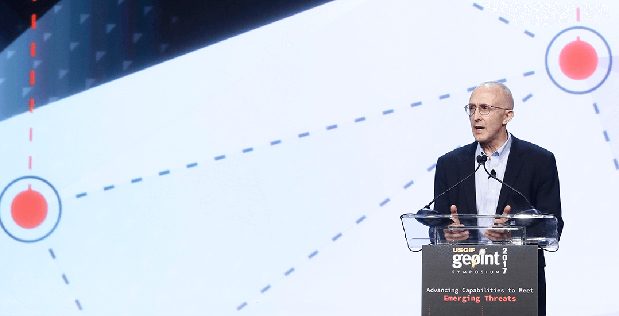The Defense Advanced Research Projects Agency is eyeing new strides in artificial intelligence and biological technology as it lays plans for fiscal 2022, its acting director said July 30.
Former DARPA Director Steven H. Walker’s departure to industry in January offers an “opportunity to rethink some of the things that we’re doing, albeit in the context of a pandemic,” Peter Highnam, the agency’s acting director, told reporters during a Defense Writers Group event.
“You’ll see increasing emphasis in AI, … 5G, space, some more directed energy. We’re in quantum [computing],” Highnam said, plus a greater push into operational biotechnology like sprayable, self-growing helicopter landing pads.
DARPA doesn’t field its own creations; instead, it partners with the armed forces and other federal entities to develop new tools and hands them off when they mature.
The organization’s annual budget hovers around $3.6 billion, a fraction of what the armed forces spend on research and development every year (for context, the Air Force wants $37.3 billion for R&D in fiscal 2021). As it decides how to most effectively spend that pot, it must avoid duplicating efforts while other Pentagon entities boost their own interest in advanced science and technology ideas.
“Are we state of the art in what we want?” Highnam said of trying to avoid overlap with the Joint AI Center, service-run research laboratories, and others poking around the same subjects. “Are we pushing it? Are we redefining it? And if not, why should DARPA do it? That’s the continuous question.”
The agency made a $2 billion, five-year investment to kickstart AI efforts in 2018, as efforts to develop smart algorithms have blossomed around the Pentagon. Since then, it’s received more than 600 proposals and awarded about $120 million under an initiative that looks to push the limits of AI research.
Computing abilities have evolved over the past few decades but aren’t truly ready to “think” on their own. DOD is pursuing AI to analyze surveillance images, consider courses of action, and build an unmanned plane that can fight a human pilot. But Highnam said there’s more to learn about training and retraining AI algorithms and getting to the point where humans know they can trust the system.
“Today, I wouldn’t do it without having humans involved, without having control laws wired in in some way,” he said. “For flight control systems, to have not just the normal flight control laws that keep the bird flying, but add some AI-enabled flexibilities to enable it to adapt to certain other conditions, but still keep within a feasible flight control envelope and guarantee that behavior. There’s so much to do there.”
Space is another research area certain to offer “DARPA-hard” problems. One of its premiere space programs, Blackjack, is proving whether 20 commercially built satellites can offer a low-cost communications network in low Earth orbit that doesn’t need ground terminals to share data. Experimental satellites will begin launching this year, and will eventually be run by the Space Force if the concept succeeds. The Pentagon’s Space Development Agency will also piggyback on Blackjack as part of a broader satellite constellation plan for missions from intelligence collection to missile tracking.
The agency will further its research into satellite technologies with the recent launch of a spacecraft that uses microelectronics to experiment with optical apertures and changing mirror shapes, Highnam said. But it’s not planning to begin a new round of its DARPA launch challenge, which fizzled in March when Astra, the last company standing, scrubbed its launch on the pad at the last minute.
“Virgin Orbit ultimately decided not to participate in the challenge in order to focus on other commercial pursuits, and Vector ran into financial trouble late last year and closed business,” DARPA noted of its other two finalists.
Eighteen companies qualified for the initiative, which offered millions of dollars in prize money to those that could successfully launch to low Earth orbit in just a few weeks rather than years.
“We learned a lot about how the market changed so quickly. … It would be great to have a few more, but the role of DARPA in driving another launch challenge, we would have to have something very specific in mind in order to warrant doing that,” Highnam said. “I don’t see the need at this moment to do something akin to the launch challenge.”
Research to help prevent the next pandemic—and respond to the ongoing one—is underway as well. DARPA is trying to learn more about coronavirus antibodies and is exploring methods of rapidly diagnosing infections by looking at how genes function.
Earlier this year, DARPA helped the Air Force test six aircraft—the C-17, KC-135, C-130J, C-5, KC-46, and KC-10—to determine which had the best air circulation and could safely transport people during the pandemic.
“The testing involved releasing and measuring test aerosols (of similar aerodynamic diameter to aerosolized coronavirus) that also contained specifically-designed DNA fragments so that collected samples could be analyzed,” DARPA spokesman Jared Adams said. “DARPA concluded that the aircraft with the most favorable airflow circulation was the KC-10, which provided complete protection to the front compartments through the use of directed airflow and smoke barriers.”
U.S. Transportation Command is continuing those coronavirus-related tests, Adams added.
